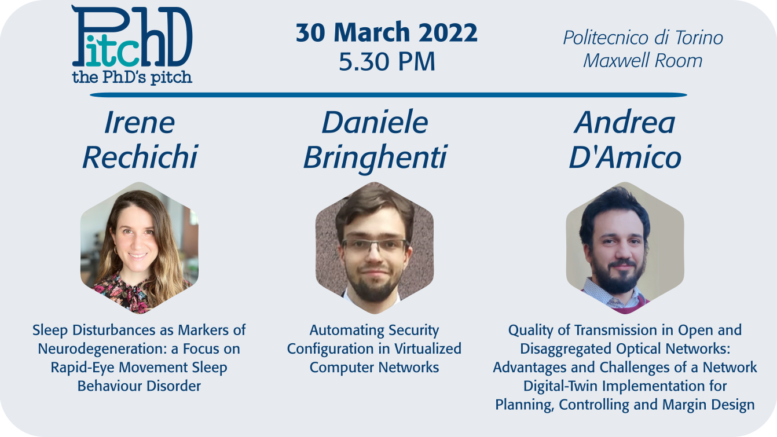30 March 2022 – 5.30 PM
Politecnico di Torino – Maxwell Room
Here’s the 2nd PitchD – the PhD’s pitch. Our PhD IEEE Student Members explain to students, colleagues and professors their research in-presence. Please, remember that registration is required to attend the event.
Sleep Disturbances as Markers of Neurodegeneration: a Focus on Rapid-Eye Movement Sleep Behaviour Disorder
Ms. Irene Rechichi
Dept. Control and Computer Engineering (DAUIN), Politecnico di Torino
Sleep plays a fundamental role in health and provides a restorative function to the organism. There is growing evidence that poor sleep quality contributes to the onset of neurodegenerative processes. Therefore, sleep disturbances are commonly acknowledged among the earliest manifestations of neurological impairment. In particular, Rapid-Eye Movement Sleep Behaviour Disorder (RBD) is considered a precursor of alpha-synucleinopathies, with high conversion rates to Parkinson’s Disease. In its idiopathic stage, RBD offers a window for disease-modifying interventions. Therefore, early detection is pivotal for developing prevention strategies and personalised follow-up procedures. However, the diagnosis is a challenging task, and most cases frequently remain undiagnosed. This talk will present a lightweight framework for the early detection of RBD from electromyographic (EMG) recordings and introduce a strategy to assess and monitor the disease progression, thus leading to personalised outcomes that may improve the subjects’ quality of life.
Automating Security Configuration in Virtualized Computer Networks
Mr. Daniele Bringhenti
Dept. Control and Computer Engineering (DAUIN), Politecnico di Torino
Network virtualization introduced higher flexibility and dynamicity, but at the same time it led to new threats and challenges. The traditional approach of a manual configuration of Network Security Functions (NSFs) such as firewalls and VPN gateways is not feasible anymore, since it is not adequate to the ever-changing nature of modern networks and it is prone to human errors. To overcome this problem, the native flexibility provided by virtualization could be exploited to automate security configuration. However, achieving a high level of automation while providing formal assurance that the security configuration fulfills some security properties is still an open research challenge. Therefore, this speech presents a novel approach combining automation, formal verification and optimization for the allocation and configuration of NSFs in virtualized networks. Specifically, this approach pursues “security by construction”, avoiding a traditional a-posteriori formal verification, and fulfills optimality criteria to improve the efficiency of the security operations.
Quality of Transmission in Open and Disaggregated Optical Networks: Advantages and Challenges of a Network Digital-Twin Implementation for Planning, Controlling and Margin Design
Mr. Andrea D’Amico
Dept. of Electronics and Telecommunications (DET), Politecnico di Torino
Optical network traffic continues to increase due to innovations and growth in end-user applications such as media streaming, cloud services, and the upcoming wide deployment of 5G networking. As a result, network operators wish to increase network capacities in a financially sustainable and costefficient manner, preferably by maximally exploiting already-installed hardware. To achieve this goal, software-defined networking (SDN) implementations have been formulated, which provide optical infrastructures with a greater degree of flexibility, exploiting capacity dynamically and efficiently, and permitting high levels of automation in network functions such as path computation and failure recovery. Simultaneously, the concept of open and disaggregated networking is gaining momentum, enabling operators to go beyond single-vendor frameworks and branch out into multi-vendor implementations. In this talk the advantages and challenges in open and disaggregated networking are presented, focusing on the application of analytical methods and artificial intelligence algorithms for quality of transmission estimation.


